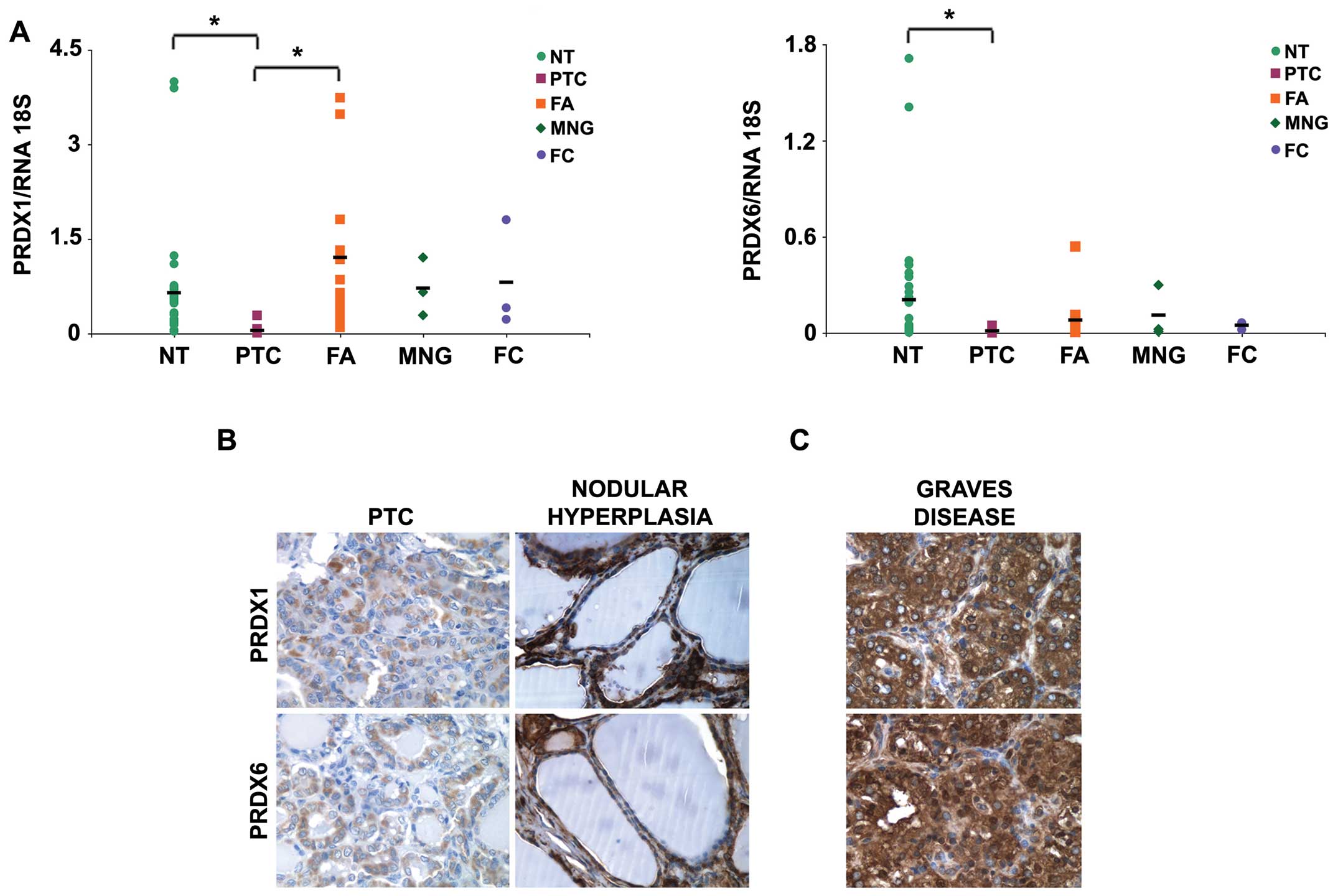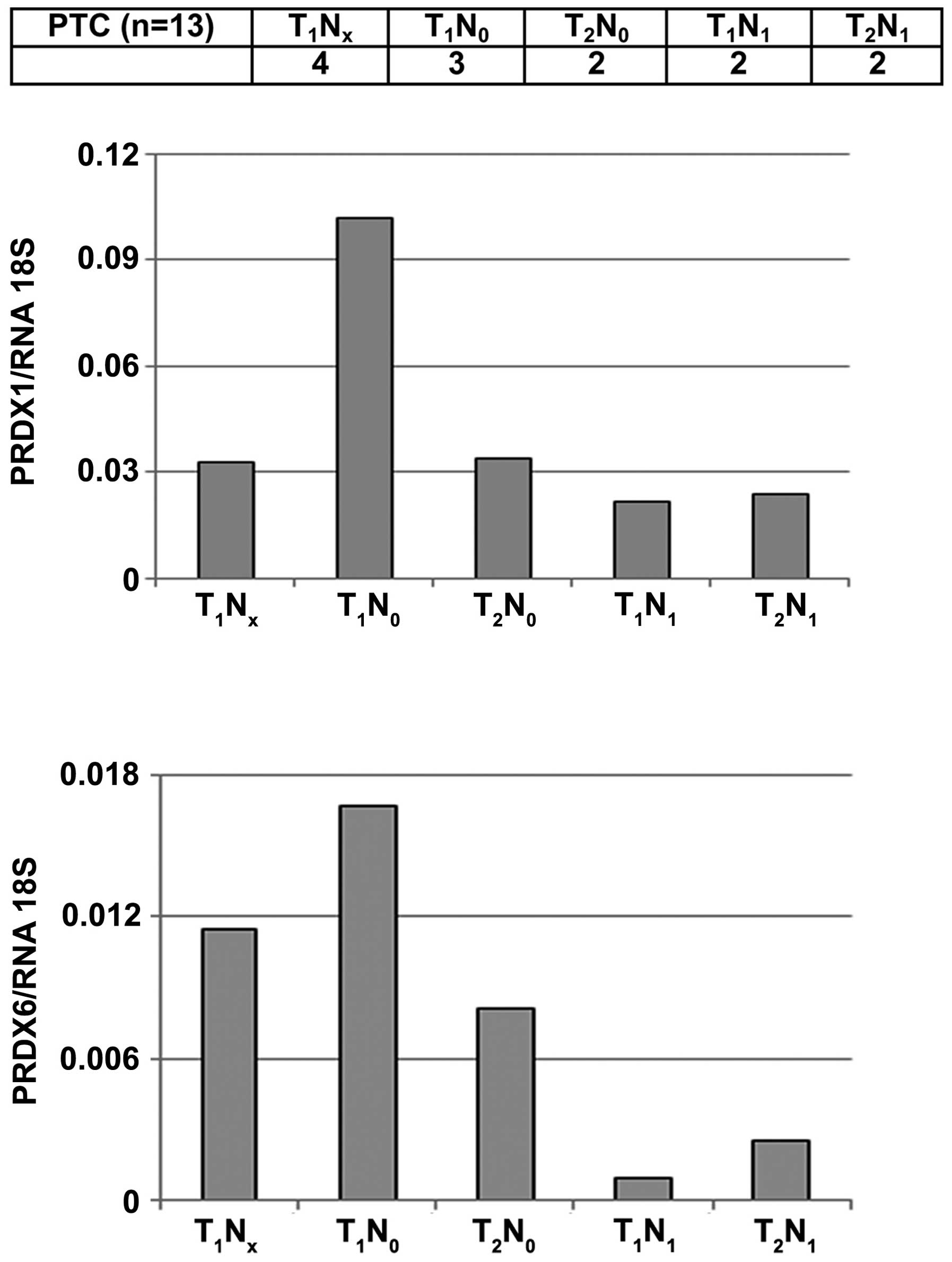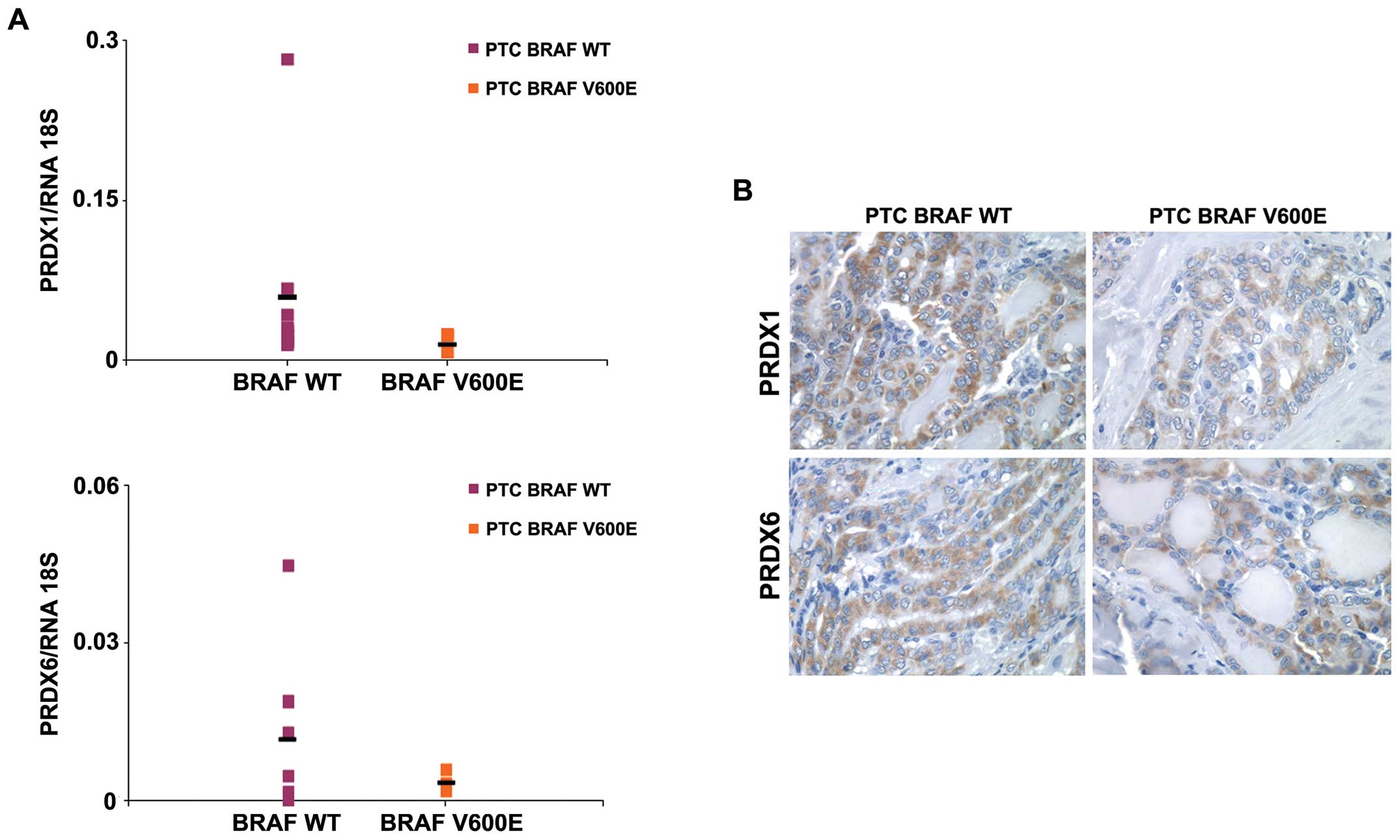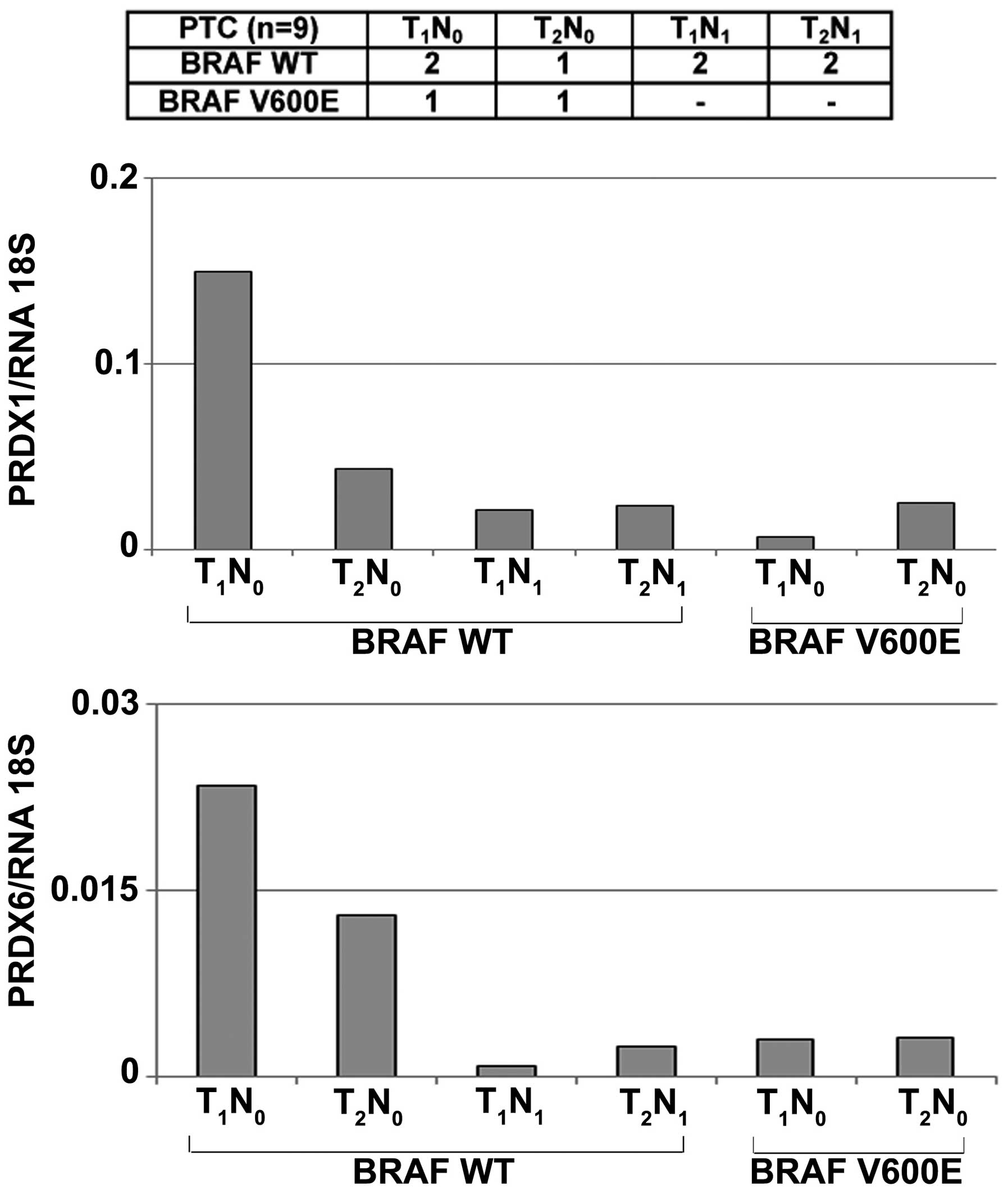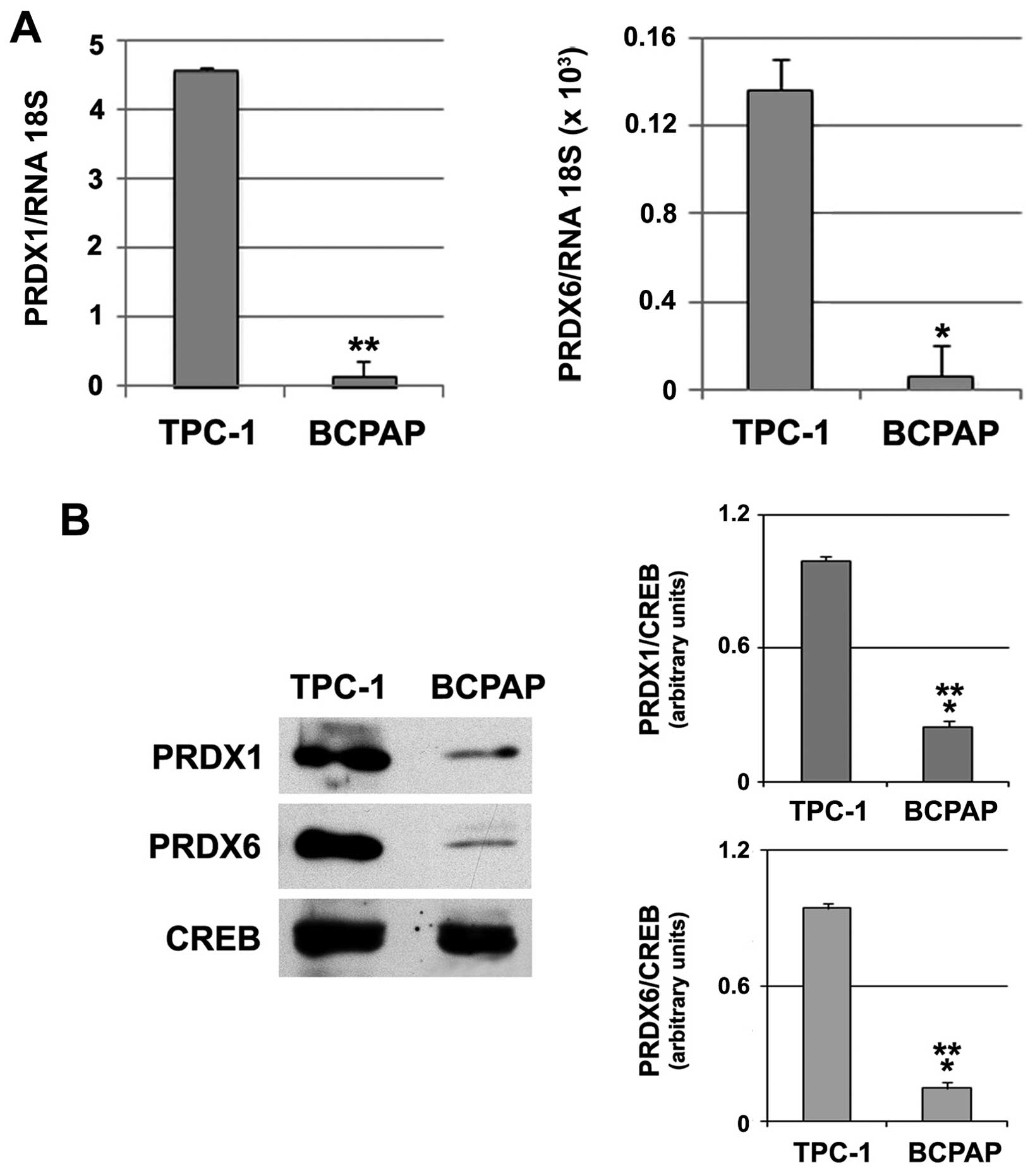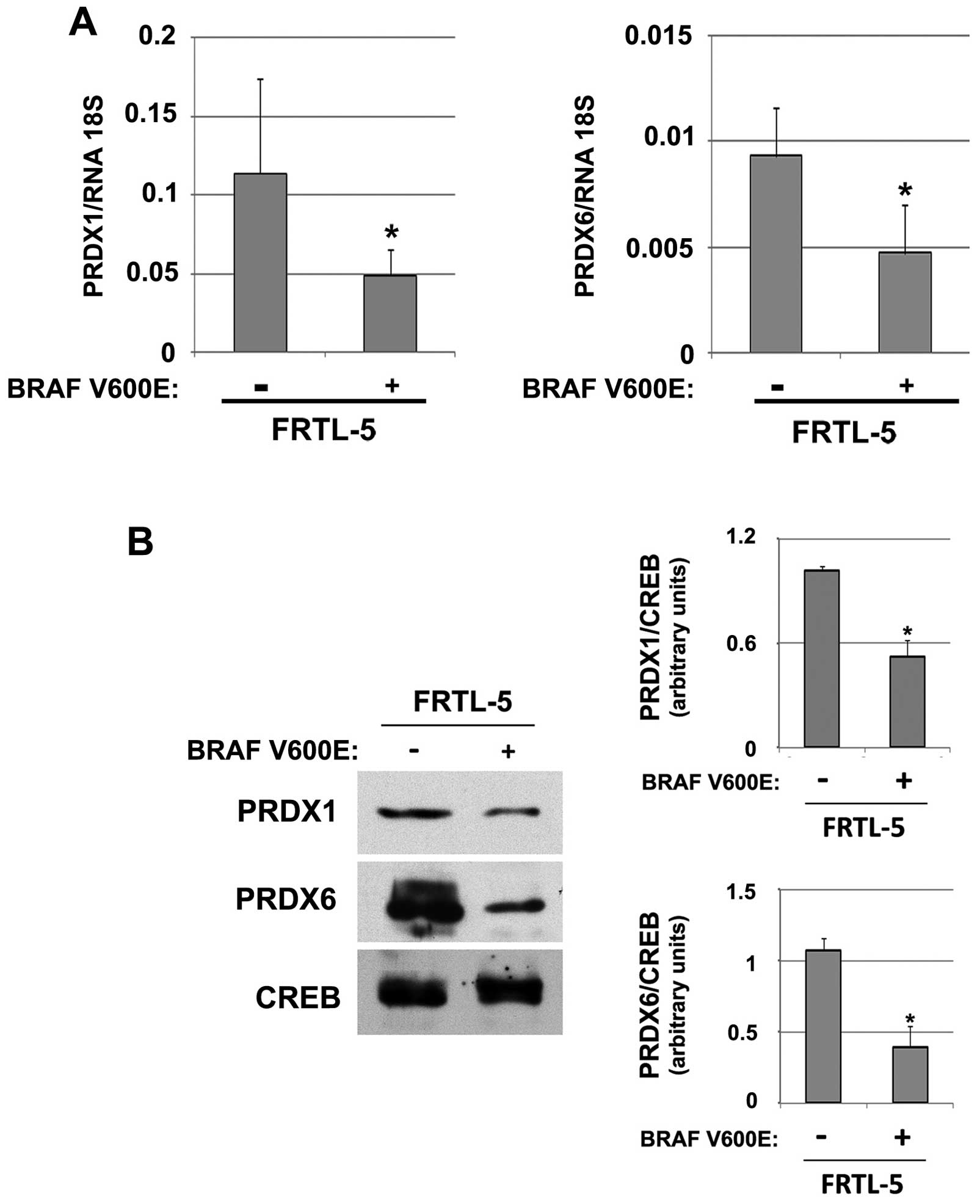|
1.
|
Senthil N and Manoharan S: Lipid
peroxidation and antioxidants status in patients with papillary
thyroid carcinoma in India. Asia Pac J Clin Nutr. 13:391–395.
2004.PubMed/NCBI
|
|
2.
|
Akinci M, Kosova F, Cetin B, Sepici A,
Altan N, Aslan S and Cetin A: Oxidant/antioxidant balance in
patients with thyroid cancer. Acta Cir Bras. 23:551–554. 2008.
View Article : Google Scholar : PubMed/NCBI
|
|
3.
|
Lassoued S, Mseddi M, Mnif F, Abid M,
Guermazi F, Masmoudi H, El Feki A and Attia H: A comparative study
of the oxidative profile in Graves’ disease, Hashimoto’s
thyroiditis, and papillary thyroid cancer. Biol Trace Elem Res.
138:107–115. 2010.PubMed/NCBI
|
|
4.
|
De Deken X, Wang D, Dumont JE and Miot F:
Characterization of ThOX proteins as components of the thyroid
H(2)O(2)-generating system. Exp Cell Res. 273:187–196.
2002.PubMed/NCBI
|
|
5.
|
Schweizer U, Chiu J and Köhrle J:
Peroxides and peroxide-degrading enzymes in the thyroid. Antioxid
Redox Signal. 10:1577–1592. 2008. View Article : Google Scholar : PubMed/NCBI
|
|
6.
|
Edgar RS, Green EW, Zhao Y, van Ooijen G,
Olmedo M, Qin X, Xu Y, Pan M, Valekunja UK, Feeney KA, Maywood ES,
Hastings MH, Baliga NS, Merrow M, Millar AJ, Johnson CH, Kyriacou
CP, O’Neill JS and Reddy AB: Peroxiredoxins are conserved markers
of circadian rhythms. Nature. 485:459–464. 2012.PubMed/NCBI
|
|
7.
|
Turner-Ivey B, Manevich Y, Schulte J,
Kistner-Griffin E, Jezierska-Drutel A, Liu Y and Neumann CA: Role
for Prdx1 as a specific sensor in redox-regulated senescence in
breast cancer. Oncogene. View Article : Google Scholar : 2013, [Epub ahead of
print].
|
|
8.
|
Manevich Y and Fisher AB: Peroxiredoxin 6,
a 1-Cys peroxiredoxin, functions in antioxidant defense and lung
phospholipid metabolism. Free Radic Biol Med. 38:1422–1432. 2005.
View Article : Google Scholar : PubMed/NCBI
|
|
9.
|
Hofmann B, Hecht HJ and Flohé L:
Peroxiredoxins. Biol Chem. 383:347–364. 2002. View Article : Google Scholar : PubMed/NCBI
|
|
10.
|
Wood ZA, Schröder E, Robin Harris J and
Poole LB: Structure, mechanism and regulation of peroxiredoxins.
Trends Biochem Sci. 28:32–40. 2003. View Article : Google Scholar : PubMed/NCBI
|
|
11.
|
Neumann CA, Krause DS, Carman CV, Das S,
Dubey DP, Abraham JL, Bronson RT, Fujiwara Y, Orkin SH and van
Etten RA: Essential role for the peroxiredoxin Prdx1 in erythrocyte
antioxidant defence and tumour suppression. Nature. 424:561–565.
2003. View Article : Google Scholar : PubMed/NCBI
|
|
12.
|
Egler RA, Fernandes E, Rothermund K,
Sereika S, De Souza-Pinto N, Jaruga P, Dizdaroglu M and Prochownik
EV: Regulation of reactive oxygen species, DNA damage, and c-Myc
function by peroxiredoxin 1. Oncogene. 24:8038–8050. 2005.
View Article : Google Scholar : PubMed/NCBI
|
|
13.
|
Neumann CA and Fang Q: Are peroxiredoxins
tumor suppressors? Curr Opin Pharmacol. 7:375–380. 2007. View Article : Google Scholar : PubMed/NCBI
|
|
14.
|
Lehtonen ST, Svensk AM, Soini Y, Pääkkö P,
Hirvikoski P, Kang SW, Säily M and Kinnula VL: Peroxiredoxins, a
novel protein family in lung cancer. Int J Cancer. 111:514–521.
2004. View Article : Google Scholar : PubMed/NCBI
|
|
15.
|
Park JH, Kim YS, Lee HL, Shim JY, Lee KS,
Oh YJ, Shin SS, Choi YH, Park KJ, Park RW and Hwang SC: Expression
of peroxiredoxin and thioredoxin in human lung cancer and paired
normal lung. Respirology. 11:269–275. 2006. View Article : Google Scholar : PubMed/NCBI
|
|
16.
|
Kim JH, Bogner PN, Baek SH, Ramnath N,
Liang P, Kim HR, Andrews C and Park YM: Up-regulation of
peroxiredoxin 1 in lung cancer and its implication as a prognostic
and therapeutic target. Clin Cancer Res. 14:2326–2333. 2008.
View Article : Google Scholar : PubMed/NCBI
|
|
17.
|
Goncalves K, Sullivan K and Phelan S:
Differential expression and function of peroxiredoxin 1 and
peroxiredoxin 6 in cancerous MCF-7 and noncancerous MCF-10A breast
epithelial cells. Cancer Invest. 30:38–47. 2012. View Article : Google Scholar : PubMed/NCBI
|
|
18.
|
Hoshino I, Matsubara H, Akutsu Y,
Nishimori T, Yoneyama Y, Murakami K, Sakata H, Matsushita K and
Ochiai T: Tumor suppressor Prdx1 is a prognostic factor in
esophageal squamous cell carcinoma patients. Oncol Rep. 18:867–871.
2007.PubMed/NCBI
|
|
19.
|
Kinnula VL, Lehtonen S, Sormunen R,
Kaarteenaho-Wiik R, Kang SW, Rhee SG and Soini Y: Overexpression of
peroxiredoxins I, II, III, V, and VI in malignant mesothelioma. J
Pathol. 196:316–323. 2002. View Article : Google Scholar : PubMed/NCBI
|
|
20.
|
Fujita Y, Nakanishi T, Hiramatsu M,
Mabuchi H, Miyamoto Y, Miyamoto A, Shimizu A and Tanigawa N:
Proteomics-based approach identifying autoantibody against
peroxiredoxin VI as a novel serum marker in esophageal squamous
cell carcinoma. Clin Cancer Res. 12:6415–6420. 2006. View Article : Google Scholar
|
|
21.
|
Park CK, Kim JH, Moon MJ, Jung JH, Lim SY,
Park SH, Kim DG, Jung HW, Cho BK and Paek SH: Investigation of
molecular factors associated with malignant transformation of
oligodendroglioma by proteomic study of a single case of rapid
tumor progression. J Cancer Res Clin Oncol. 134:255–262. 2008.
View Article : Google Scholar : PubMed/NCBI
|
|
22.
|
Karihtala P, Mantyniemi A, Kang SW,
Kinnula VL and Soini Y: Peroxiredoxins in breast carcinoma. Clin
Cancer Res. 9:3418–3424. 2003.PubMed/NCBI
|
|
23.
|
Rolfs F, Huber M, Gruber F, Böhm F,
Pfister HJ, Bochkov VN, Tschachler E, Dummer R, Hohl D, Schäfer M
and Werner S: Dual role of the antioxidant enzyme peroxiredoxin 6
in skin carcinogenesis. Cancer Res. 73:3460–3469. 2013. View Article : Google Scholar : PubMed/NCBI
|
|
24.
|
Yanagawa T, Ishikawa T, Ishii T, Tabuchi
K, Iwasa S, Bannai S, Omura K, Suzuki H and Yoshida H:
Peroxiredoxin I expression in human thyroid tumors. Cancer Lett.
145:127–132. 1999. View Article : Google Scholar : PubMed/NCBI
|
|
25.
|
Sofiadis A, Becker S, Hellman U,
Hultin-Rosenberg L, Dinets A, Hulchiy M, Zedenius J, Wallin G,
Foukakis T, Höög A, Auer G, Lehtiö J and Larsson C: Proteomic
profiling of follicular and papillary thyroid tumors. Eur J
Endocrinol. 166:657–667. 2012. View Article : Google Scholar : PubMed/NCBI
|
|
26.
|
Leenhardt L, Grosclaude P and
Chérié-Challine L: Thyroid Cancer Committee. Increased incidence of
thyroid carcinoma in France: a true epidemic or thyroid nodule
management effects? Report from the French Thyroid Cancer Committee
Thyroid. 14:1056–1060. 2004.PubMed/NCBI
|
|
27.
|
Davies L and Welch HG: Increasing
incidence of thyroid cancer in the United States, 1973–2002. JAMA.
295:2164–2167. 2006.
|
|
28.
|
Mazzaferri EL: Management of low-risk
differentiated thyroid cancer. Endocr Pract. 13:498–512. 2007.
View Article : Google Scholar : PubMed/NCBI
|
|
29.
|
Roti E, Degli Uberti EC, Bondanelli M and
Braverman LE: Thyroid papillary microcarcinoma: a descriptive and
meta-analysis study. Eur J Endocrinol. 159:659–673. 2008.
View Article : Google Scholar : PubMed/NCBI
|
|
30.
|
Nikiforova MN, Kimura ET, Gandhi M,
Biddinger PW, Knauf JA, Basolo F, Zhu Z, Giannini R, Salvatore G,
Fusco A, Santoro M, Fagin JA and Nikiforov YE: BRAF mutations in
thyroid tumors are restricted to papillary carcinomas and
anaplastic or poorly differentiated carcinomas arising from
papillary carcinomas. J Clin Endocrinol Metab. 88:5399–5404. 2003.
View Article : Google Scholar : PubMed/NCBI
|
|
31.
|
Xing M: Prognostic utility of BRAF
mutation in papillary thyroid cancer. Mol Cell Endocrinol.
321:86–93. 2010. View Article : Google Scholar : PubMed/NCBI
|
|
32.
|
Xing M: Molecular pathogenesis and
mechanisms of thyroid cancer. Nat Rev Cancer. 13:184–199. 2013.
View Article : Google Scholar : PubMed/NCBI
|
|
33.
|
Lazzereschi D, Ranieri A, Mincione G,
Taccogna S, Nardi F and Colletta G: Human malignant thyroid tumors
displayed reduced levels of transforming growth factor beta
receptor type II messenger RNA and protein. Cancer Res.
57:2071–2076. 1997.
|
|
34.
|
Ambesi-Impiombato FS, Parks LA and Coon
HG: Culture of hormone-dependent functional epithelial cells from
rat thyroids. Proc Natl Acad Sci USA. 77:3455–3459. 1980.
View Article : Google Scholar : PubMed/NCBI
|
|
35.
|
D’Inzeo S, Nicolussi A, Donini CF, Zani M,
Mancini P, Nardi F and Coppa A: A novel human Smad4 mutation is
involved in papillary thyroid carcinoma progression. Endocr Relat
Cancer. 19:39–55. 2012.PubMed/NCBI
|
|
36.
|
Schweppe RE, Klopper JP, Korch C,
Pugazhenthi U, Benezra M, Knauf JA, Fagin JA, Marlow LA, Copland
JA, Smallridge RC and Haugen BR: Deoxyribonucleic acid profiling
analysis of 40 human thyroid cancer cell lines reveals
cross-contamination resulting in cell line redundancy and
misidentification. J Clin Endocrinol Metab. 93:4331–4341. 2008.
View Article : Google Scholar
|
|
37.
|
D’Inzeo S, Nicolussi A, Ricci A, Mancini
P, Porcellini A, Nardi F and Coppa A: Role of reduced expression of
SMAD4 in papillary thyroid carcinoma. J Mol Endocrinol. 45:229–244.
2010.PubMed/NCBI
|
|
38.
|
Nicolussi A, D’Inzeo S, Gismondi A and
Coppa A: Reduction of invasive potential in K-ras-transformed
thyroid cells by restoring of TGF-beta pathway. Clin Exp
Metastasis. 23:237–248. 2006. View Article : Google Scholar : PubMed/NCBI
|
|
39.
|
Meireles AM, Preto A, Rocha AS, Rebocho
AP, Máximo V, Pereira-Castro I, Moreira S, Feijão T, Botelho T,
Marques R, Trovisco V, Cirnes L, Alves C, Velho S, Soares P and
Sobrinho-Simões M: Molecular and genotypic characterization of
human thyroid follicular cell carcinoma-derived cell lines.
Thyroid. 17:707–715. 2007. View Article : Google Scholar : PubMed/NCBI
|
|
40.
|
Poncin S, Colin IM and Gérard AC: Minimal
oxidative load: a prerequisite for thyroid cell function. J
Endocrinol. 201:161–167. 2009. View Article : Google Scholar : PubMed/NCBI
|
|
41.
|
Maier J, van Steeg H, van Oostrom C,
Paschke R, Weiss RE and Krohn K: Iodine deficiency activates
antioxidant genes and causes DNA damage in the thyroid gland of
rats and mice. Biochim Biophys Acta. 1773:990–999. 2007. View Article : Google Scholar : PubMed/NCBI
|
|
42.
|
Gérard AC, Many MC, Daumerie Ch, Knoops B
and Colin IM: Peroxiredoxin 5 expression in the human thyroid
gland. Thyroid. 15:205–209. 2005.PubMed/NCBI
|
|
43.
|
Xing M: Oxidative stress: a new risk
factor for thyroid cancer. Endocr Relat Cancer. 19:C7–C11. 2012.
View Article : Google Scholar : PubMed/NCBI
|
|
44.
|
Wang D, Feng JF, Zeng P, Yang YH, Luo J
and Yang YW: Total oxidant/antioxidant status in sera of patients
with thyroid cancers. Endocr Relat Cancer. 18:773–782. 2011.
View Article : Google Scholar : PubMed/NCBI
|
|
45.
|
Cohen Y, Xing M, Mambo E, Guo Z, Wu G,
Trink B, Beller U, Westra WH, Ladenson PW and Sidransky D: BRAF
mutation in papillary thyroid carcinoma. J Natl Cancer Inst.
95:625–627. 2003. View Article : Google Scholar : PubMed/NCBI
|
|
46.
|
Fukushima T, Suzuki S, Mashiko M, Ohtake
T, Endo Y, Takebayashi Y, Sekikawa K, Hagiwara K and Takenoshita S:
BRAF mutations in papillary carcinomas of the thyroid. Oncogene.
22:6455–6457. 2003. View Article : Google Scholar : PubMed/NCBI
|
|
47.
|
Kimura ET, Nikiforova MN, Zhu Z, Knauf JA,
Nikiforov YE and Fagin JA: High prevalence of BRAF mutations in
thyroid cancer: genetic evidence for constitutive activation of the
RET/PTC-RASBRAF signaling pathway in papillary thyroid carcinoma.
Cancer Res. 63:1454–1457. 2003.PubMed/NCBI
|
|
48.
|
Xu X, Quiros RM, Gattuso P, Ain KB and
Prinz RA: High prevalence of BRAF gene mutation in papillary
thyroid carcinomas and thyroid tumor cell lines. Cancer Res.
63:4561–4567. 2003.PubMed/NCBI
|
|
49.
|
Frasca F, Nucera C, Pellegriti G, Gangemi
P, Attard M, Stella M, Loda M, Vella V, Giordano C, Trimarchi F,
Mazzon E, Belfiore A and Vigneri R: BRAF (V600E) mutation and the
biology of papillary thyroid cancer. Endocr Relat Cancer.
15:191–205. 2008. View Article : Google Scholar : PubMed/NCBI
|
|
50.
|
Watanabe R, Hayashi Y, Sassa M, Kikumori
T, Imai T, Kiuchi T and Murata Y: Possible involvement of BRAFV600E
in altered gene expression in papillary thyroid cancer. Endocr J.
56:407–414. 2009. View Article : Google Scholar : PubMed/NCBI
|
|
51.
|
Hu S, Liu D, Tufano RP, Carson KA,
Rosenbaum E, Cohen Y, Holt EH, Kiseljak-Vassiliades K, Rhoden KJ,
Tolaney S, Condouris S, Tallini G, Westra WH, Umbricht CB, Zeiger
MA, Califano JA, Vasko V and Xing M: Association of aberrant
methylation of tumor suppressor genes with tumor aggressiveness and
BRAF mutation in papillary thyroid cancer. Int J Cancer.
119:2322–2329. 2006. View Article : Google Scholar : PubMed/NCBI
|
|
52.
|
Guan H, Ji M, Hou P, Liu Z, Wang C, Shan
Z, Teng W and Xing M: Hypermethylation of the DNA mismatch repair
gene hMLH1 and its association with lymph node metastasis and
T1799A BRAF mutation in patients with papillary thyroid cancer.
Cancer. 113:247–255. 2008. View Article : Google Scholar : PubMed/NCBI
|
|
53.
|
Riesco-Eizaguirre G, Rodríguez I, De la
Vieja A, Costamagna E, Carrasco N, Nistal M and Santisteban P: The
BRAFV600E oncogene induces transforming growth factor beta
secretion leading to sodium iodide symporter repression and
increased malignancy in thyroid cancer. Cancer Res. 69:8317–8325.
2009. View Article : Google Scholar
|
|
54.
|
Knauf JA, Sartor MA, Medvedovic M,
Lundsmith E, Ryder M, Salzano M, Nikiforov YE, Giordano TJ,
Ghossein RA and Fagin JA: Progression of BRAF-induced thyroid
cancer is associated with epithelial-mesenchymal transition
requiring concomitant MAP kinase and TGFβ signaling. Oncogene.
30:3153–3162. 2011.PubMed/NCBI
|
|
55.
|
Ji D, Li M, Zhan T, Yao Y, Shen J, Tian H,
Zhang Z and Gu J: Prognostic role of serum AZGP1, PEDF and PRDX2 in
colorectal cancer patients. Carcinogenesis. 34:1265–1272. 2013.
View Article : Google Scholar
|
|
56.
|
Park YH, Kim SU, Lee BK, Kim HS, Song IS,
Shin HJ, Han YH, Chang KT, Kim JM, Lee DS, Kim YH, Choi CM, Kim BY
and Yu DY: Prx I suppresses K-ras-driven lung tumorigenesis by
opposing redox-sensitive ERK/cyclin D1 pathway. Antioxid Redox
Signal. 19:482–496. 2013. View Article : Google Scholar : PubMed/NCBI
|















